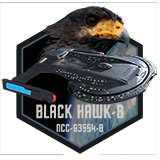The computers on board a ship or station are immense, with the core extending down through multiple decks. Next to the crew, the computer is probably the most important single operational element. It could be and has been described as being the central nervous system of the ship or station. It is responsible in some way for the operation of virtually every other system. The maintenance and upgrading of this system is an immense task and one that falls under the responsibilities of the Operations department. Extensive programming knowledge and skills are required and the ability to quickly diagnose and correct any problems are mandatory.
Maintenance
The main interface used by virtually every crewmember is provided by the Library Computer Access and Retrieval System software (LCARS). LCARS provides both keyboard and vocal interface ability. It is composed of highly artificial intelligence routines. These routines have the ability to run diagnostics on itself to check for anomalies, but the output must always be reviewed by the Operations officer before being signed off as operating within standard parameters. Periodically these routines need to be upgraded or additions and enhancements added. This is done by the Operations officer. No one except the Operations officer, the XO and the CO have access to the central core operating system.
Alert Maintenance
Depending on the Operating mode on the ship, diagnostics are run on different schedules. Although separate departments are scanned depending on the situation, the computer systems within those areas are also included.
Cruise Mode
- A level 4 diagnostic are run on the entire computer system throughout the entire ship at the beginning of each shift.
Yellow Alert
- Level 4 diagnostic run on all ship's primary & tactical computer systems to determine ship's current readiness status. This also includes the computer systems in the engineering department, concentrating on the warp core and engine computers systems.
- Level 5 automatic diagnostics are performed to verify systems that maintain the readiness of autonomous survival and govern the recovery vehicle systems (lifeboats).
Red Alert
- Level 4 diagnostic run on all ship's primary & tactical computer systems. Operations is given immediate notification of any significant change in the ship's power and computer systems while the bridge is given immediate notice of any change in the ship's readiness status.
- Immediate Level 3 diagnostic on the computer systems that monitor warp propulsion systems, level 4 series at every 5 minutes
- Level 3 diagnostics to the computers systems that control the phaser banks
- Level 4 automatic diagnostics are performed to verify systems that maintain the readiness of autonomous survival and govern the recovery vehicle systems (lifeboats).
Whenever a system has crashed a Level 1 diagnostic will be run on that system. And whenever it is feasible a level 1 is run on the entire core and network. This is usually done when docked and the major systems are run from the station or port through an umbilical cord thus ensuring that life support, power and engineering are not interrupted in anyway.
Software and Data Storage and Retrieval
Isolinear optical chips are a sophisticated information storage and processing device that can be used for both data storage and processing. Composed of linear memory crystal material, these isolinear chips are often mounted in wall racks permitting the computer access to anywhere from a dozen up to hundreds of chips at one time. These must be regularly check for both physical or data damage. These chips can be found in almost every unit and system.
User Access and Control Interfaces
These functions are quite complex and have required their own entries:
| OPERATIONS DEPARTMENT | |
| IMPORTANT ERRATA | Operations Department • Operations Positions • Access Codes • Bio-neural circuitry • Communications • Computer Access Levels • Duty Roster • LCARS Administration • Mission Operations • ODN Network • Operating Modes • Personnel Allocation • Resource Allocation • Transportation • Ship Specifications |
| NOTABLE LOCATIONS | Chief Operations Officer's Office • Computer Core • Main Engineering • Auxiliary Control |
| PERSONNEL FUNCTIONS | Alert Status • Cabin Assignments • Computer Access Levels • Deck Listing • Department Head • Duty Roster • Operating Modes • Security Clearances • Rank Guide • Rank Comparisons • Uniforms |
| DEPARTMENTS | Command • Flight Control • Intelligence • Operations • Engineering Security/Tactical • Medical • Science • Squadron • Civilians |
